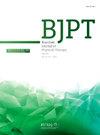转介的人腰痛物理治疗师在巴西初级卫生保健:一个挑战揭示。
IF 3.2
3区 医学
Q1 ORTHOPEDICS
引用次数: 0
摘要
背景:腰痛(LBP)是世界范围内的一种致残疾病,目前的证据表明,转诊到物理治疗师的比例很低,并且广泛使用低价值的干预措施,如药物治疗和急诊。目的:调查巴西初级保健物理治疗师的转诊频率和LBP患者的特征,以及临床和社会人口统计学方面的特征以及卫生资源的使用。方法:观察性研究,使用全国1,459,710例LBP成人数据,按G1:仅接受医疗护理,G2:接受医疗护理并转诊给物理治疗师,G3:首次接触物理治疗师进行分层。对数据进行描述性分析。结果:G1期纳入1405145例LBP患者,其次是G2 (N: 14079)和G3 (N: 40486)。以女性居多(56.3%),女性平均年龄49(±17)岁,男性平均年龄48(±17)岁。不到1% (G2)被转介给物理治疗师。其中,8085例(57.4%)患者从转诊到临床预约的平均时间为17.4天(±65.6天),5994例(42.6%)患者的持续时间更长(261.1±146.9天)。共有130,570(8.9%)参与者被转介进行影像学检查,共计152,150次检查。G1每1000人有105.65次检查,每1000人有128次转介专家。G2检查次数为196.32次,专家转诊次数为384.76次/1000人,G3检查次数为22.87次,专家转诊次数为64.89次/1000人。结论:我们发现,巴西初级卫生保健机构中,LBP患者转介给物理治疗师的人数相对较少,而且从转介到首次接触该专业人员之间的时间间隔较长。此外,诊断成像和转诊给专家是经常使用。本文章由计算机程序翻译,如有差异,请以英文原文为准。
Referral of people with low back pain to physical therapists in Brazilian primary healthcare: A challenge revealed
Background
Low back pain (LBP) is a disabling condition worldwide, and current evidence suggests low rates of referral to physical therapists and extensive use of low-value interventions such as pharmacological treatments and emergency visits.
Objective
To investigate the frequency of referrals and characterize people with LBP accessing primary care physical therapists, as well as characterize clinical and sociodemographic aspects and the use of health resources in Brazil.
Method
Observational study using nationwide data on 1,459,710 adults with LBP, stratified according to G1: medical care only, G2: medical care and referral to physical therapist, G3: physical therapist as first contact. Data were analyzed descriptively.
Results
1,405,145 people with LBP were included in G1, followed by G2 (N:14,079), and G3 (N:40,486). The majority was female (56.3 %), and the average age was 49 (±17) years for females and 48 (±17) for males. Less than 1 % (G2) were referred to physical therapists. Of these, 8085 (57.4 %) had an average duration of 17.4 days (±65.6) between referral and their clinical appointment, and 5994 (42.6 %) had a longer duration (261.1 ± 146.9 days). A total of 130,570 (8.9 %) participants were referred for imaging, totaling 152,150 exams. G1 had 105.65 exams/1000 people and 128 referrals to specialists/1000 people. G2 had 196.32 exams and 384.76 referrals to specialists/1000 people, and G3 had 22.87 exams and 64.89 referrals to specialists/1000 people.
Conclusion
We found a relatively low number of referrals of people with LBP to physical therapists in primary health care in Brazil, and a long period between the referral and the first contact with this professional. In addition, diagnostic imaging and referral to a specialist were frequently used.
求助全文
通过发布文献求助,成功后即可免费获取论文全文。
去求助
来源期刊
CiteScore
6.10
自引率
8.80%
发文量
53
审稿时长
74 days
期刊介绍:
The Brazilian Journal of Physical Therapy (BJPT) is the official publication of the Brazilian Society of Physical Therapy Research and Graduate Studies (ABRAPG-Ft). It publishes original research articles on topics related to the areas of physical therapy and rehabilitation sciences, including clinical, basic or applied studies on the assessment, prevention, and treatment of movement disorders.

 求助内容:
求助内容: 应助结果提醒方式:
应助结果提醒方式:


